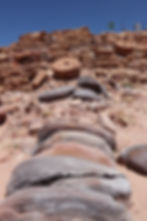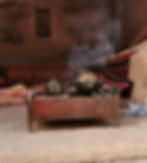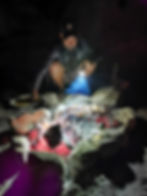Petra, the "Lost City"
- Cheryl
- Aug 25, 2023
- 5 min read
Updated: Sep 7, 2023
Eight hundred and fifty steps loom ahead of us, leading us back in time to the ancient city of Petra. Paleolithic and Neolithic humans trod here for millennia, settling in the surrounding area from as early at 7000 BCE.

But it was the Nabataeans, a Bedouin nomadic tribe dating back to 2000 BCE who, almost unbelievably, in the midst of a barren harsh desert established Petra as their capital city. Highly skilled at desert survival the Nabataeans developed an advanced system of rock cut channels and a sophisticated water pipe system to carry water from springs and seasonal streams to cisterns, creating a veritable oasis.

Stone shaded cisterns kept the water cool as well as keeping them concealed from enemies.
Photo: Noel Van Raes

The flourishing city became a main stopping point for nomadic merchants—camels laden with heavy loads of valuable goods—incense, spices, ivory, fabric. In addition to charges for shelter and water, tolls were levied to foreign traders for safe passage through their territory, thereby controlling trade routes and generating riches and prosperity.

The only loads camels carry today in Petra are tourists. Photo: Noel Van Raes


It wasn’t only exotic goods that trade brought to the Nabataeans—culture and new ideas flowed in. With wealth, a stunning array of buildings, clearly influenced by Greece and Egypt were literally hand chiseled out of the sandstone rock, making Petra a cultural centre in the ancient world.
But it wasn’t to last. In 106 CE, after flourishing for four hundred years, the Nabaetean Empire was taken over, apparently peacefully, by the Roman Empire. The romanization of Petra had begun—leaving monuments, sculptures, roads, and public spaces forever changed.
Taking our first step we begin the upward journey high into the hills to the Monastery, located northwest of the Petra city centre. Believed to be built for religious purposes it is one of the most iconic buildings in Petra.
We’ve chosen to come in the recently opened back way, much less popular with tourists, arriving at the 6:30 a.m. opening time to beat the crowds.
We carefully watch our footing—each step hewed out of the rock is a different size and height, some smooth, some rough, some that only half of a foot fits on. Did I mention the massive gooey piles of donkey poo? Some tourists miscalculate the energy required and succumb to the sales pitches of donkey rides—rides that amount to cruelty for the animals—but that’s another story.

We quickly come to appreciate the light chill breeze as we huff and puff up the stairs, stopping often to catch our breath. With each stop we gorge on the dynamic ever- changing landscape as the colours of the rocks morph from brown to red as the sun rises.

An hour later, catching our first glimpse of the Monastery we’re blown away. Despite researching and watching videos, nothing has prepared us for our first sight of Petra. Breathtaking is an overused word, but that is what it is.


We watch mesmerized as the rising sun sets the sand stone Monastery aglow, changing from muted browns to vibrant pinks and reds, earning Petra the nickname The Rose City.

Independent travel gives us the option to take our time, but it is still reluctantly that we pull ourselves away from this captivating site to begin the downhill four kilometre trek to the city centre,
Going down proves to be more challenging. Narrow steps mean sometimes going down sideways while avoiding deepening ruts in the stairs—a result of the constant assault of donkey hooves carrying a multitude of tourists. Care must also be taken to keep clear of the donkeys—seemingly convinced that the paths are theirs, they refuse to give way.
But extra caution is a small price to pay—we drink in panoramic views punctuated by a treasure trove of magnificent ruins, their majesty and splendour ours to explore.

Qsar-al-Bint, ancient Petra's main temple is the most well preserved freestanding structure.





Mosaic tile floors are still visible in the ruins of the Petra church, once a grand cathedral with massive pillars. Photo: Noel Van Raes






Just as in ancient times trade remains an integral part of Petra and vendors squeeze in shops in every nook and cranny, creating buzzing bazaars selling something for everyone—wool, jewelry, rocks, jars of sand, clay camels, carpets, scarves, coins. Exotic “authentic artifacts” are flogged everywhere.




Although the cave dwelling Bedouins were forced out of Petra when it became a UNESCO site in 1985, they still dominate commerce, manning the shops, offering guide services, and donkey and camel rides.





Getting hungry and needing a rest, we stop at a coffee/tea stall. Taking advice from our hotel manager we have packed our own lunch—falafel sandwiches and fresh figs. Bedouins, known for their hospitality welcome us like family.

Not much has changed—no stoves here—only a small wood fire to boil the water. Tea is freshly brewed black tea, served in a small glass with mint leaves added for extra flavour, and sweetening to taste. Noel opts for coffee which is always of the very strong Turkish variety with cardamon pods often added.



From here it’s a short walk to the Treasury, sculpted deeply into the rock face. We’re struck by how well preserved it is. But the crowds are thickening. It is too chaotic to take it in—tourists vie for space to take selfies, while others board camels for the ultimate shot.

We too are looking for the perfect photo, but for us this is an extra special trip. It is our 50th anniversary—a celebration of our adventures and the many roads we have travelled together—55 countries and counting. Our three daughters surprised us—actually it was more like a shock—by arranging a professional photographer to take photos of us at Petra—not an easy feat as we plan very little ahead and confirm dates on the go.
As we head out via the main entrance—the Siq—a dramatic narrow gorge with 80 metre high peculiarly eroded walls, we receive a message from our photographer, Fiona.




Fiona is a young woman from Britain who has fallen in love with a Jordanian and just moved to Petra. Her partner, a guide, in typical Jordanian hospitality has offered to take us to a special spot, unknown to tourists where we can watch the sun rise over Petra, before returning to the city centre in the quiet stillness of the following morning.

But our day did not end there—Jordanian hospitality continues and they invite us to dinner in the dessert. Who could refuse an offer like that!




It is difficult to believe that the once great metropolis of Petra, lay lost in the mists of time to the outside world for five hundred years.
Fortunes fell as trade routes changed with the development of sailing ships. A devastating earthquake dealt the final blow in 363 CE, leveling many of the city’s buildings and destroying the water system. By 700 CE only a few people lived in and around Petra.
It wasn’t until 1812 that a Swiss explorer, Johann Ludwig, masquerading as as a Muslim Indian merchant rediscovered the ancient city, bringing his sketches and writings of Petra to the outside world.
Now this once bustling city is again on the world stage, chosen as one of the Seven Wonders of the New World in 2011. Many will also recognize Petra’s unique landscape as the backdrop for movies—Indiana Jones and the Last Crusade, The Mummy Returns, Aladdin.
But many mysteries remain in this fabled city—with only about 15% excavated, many secrets are yet to be revealed.
A few days later the photos arrive in my inbox—amazing memories of an amazing anniversary in one of the most amazing places on earth.

